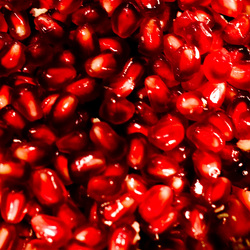
Pomegranate is among the most popular, nutritionally rich fruit. Pomegranate is an excellent source of essential amino acids, vitamin A, C, E, B5, B3 or Niacin, Iron, folic acid, potassium, and antioxidant polyphenols.
The iron in pomegranate helps to prevent anemia symptoms that include dizziness, weakness, exhaustion. The research shows that Pomegranate has a very high level of polyphenol content which is a powerful antioxidant. Researches show that the content of antioxidant in pomegranate is higher than that of red wine, or green tea. In fact, pomegranate contains more antioxidants than any other natural food source. Thus, the major health benefits come from the high levels of antioxidants, specifically polyphenols, tannins and anthocyanins which are important in fighting free radicals which cause various types of diseases and aging.
Health benefits include:
How to Select
Choose large, firm and smooth-skinned pomegranate. A good quality pomegranate should have rich color, and has no cuts or blemishes.
How to store
Pomegranate can be stored at cool and dry place for up to one month. It can last for about two months if kept refrigerated.
How to prepare
Slice off the top. Score the skin in quarters and open it up. Then put each quarter underwater and use your fingers to ream the seeds from the inside. The seeds sink, and the white membrane floats. Pour off the membranes so the seeds remain.
Besides eating the seeds raw, you can also use them as garnishes for salads and desserts.
The iron in pomegranate helps to prevent anemia symptoms that include dizziness, weakness, exhaustion. The research shows that Pomegranate has a very high level of polyphenol content which is a powerful antioxidant. Researches show that the content of antioxidant in pomegranate is higher than that of red wine, or green tea. In fact, pomegranate contains more antioxidants than any other natural food source. Thus, the major health benefits come from the high levels of antioxidants, specifically polyphenols, tannins and anthocyanins which are important in fighting free radicals which cause various types of diseases and aging.
Health benefits include:
- Prevention of heart disease due to the high content of the antioxidants.
- Reduction of bad LDL cholesterol levels.
- Helping in reducing the plaque deposits in the arteries and prevent clotting of blood.
- The research has showed that regular consumption of pomegranate is effective against prostate cancer, diabetes, and lymphoma.
- The vitamin C in pomegranate helps to fight any kind of infections.
- Possession of anti-inflammatory properties which can help in bringing the inflammation down.
- Pomegranate is also good for your teeth since it possesses antibacterial compounds which can be helpful in preventing dental plaque.
How to Select
Choose large, firm and smooth-skinned pomegranate. A good quality pomegranate should have rich color, and has no cuts or blemishes.
How to store
Pomegranate can be stored at cool and dry place for up to one month. It can last for about two months if kept refrigerated.
How to prepare
Slice off the top. Score the skin in quarters and open it up. Then put each quarter underwater and use your fingers to ream the seeds from the inside. The seeds sink, and the white membrane floats. Pour off the membranes so the seeds remain.
Besides eating the seeds raw, you can also use them as garnishes for salads and desserts.
 RSS Feed
RSS Feed